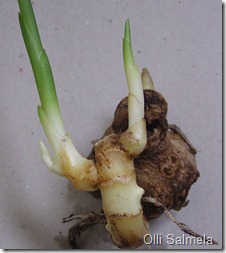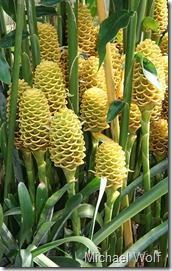 By Birgit ‘B’ Bradtke – Guest Contributor
By Birgit ‘B’ Bradtke – Guest Contributor
When I began growing ginger I expected it to be difficult, but it’s not. I’ve been growing ginger at home for years and it is a serious contender for the title of “most neglected plant” in my garden. In fact, I look at my ginger plants exactly once a year at harvest time. I harvest them, replant them and then forget about them for another year. I easily grow a year’s supply of ginger and have plenty left over to give away. You can grow your own ginger using store-bought ginger root and you can easily grow it in pots or tubs. On this page I tell you everything you need to know about growing ginger, so you can grow your own fresh ginger, too.
Growing ginger root is not that hard provided you get a few basics right. Below is a picture of a rhizome. When talking about the edible part of the ginger plant, the term “ginger root” is actually incorrect because you don’t eat the roots, you eat the rhizomes. As you can see, rhizomes have roots, which are two different things. But I’ll keep talking about ginger root anyway, that’s what everybody does and you know what I mean.
 The easiest way to start growing ginger is to get a few fresh rhizomes from someone who grows ginger. The best time to do this is in spring when the plant sends up shoots. Otherwise, buy some at the grocery store. Make sure you select fresh, plump rhizomes. Look for pieces with well developed “eyes” or growth buds, which look like little horns at the end of the piece, or “finger”. Some people recommend soaking the rhizomes in water overnight before planting. That’s not a bad idea, since store-bought ginger might have been treated with a growth retardant.
The easiest way to start growing ginger is to get a few fresh rhizomes from someone who grows ginger. The best time to do this is in spring when the plant sends up shoots. Otherwise, buy some at the grocery store. Make sure you select fresh, plump rhizomes. Look for pieces with well developed “eyes” or growth buds, which look like little horns at the end of the piece, or “finger”. Some people recommend soaking the rhizomes in water overnight before planting. That’s not a bad idea, since store-bought ginger might have been treated with a growth retardant.
Some suggest placing rhizomes in water until they sprout roots, but that’s nonsense. Your ginger plant will be much happier in the ground, rather than having to deal with the transplanting shock and the change in conditions. If the ground is moist and warm, the rhizomes will root very easily.
Whether you grow ginger in a pot or in the ground, you need good soil to start with. It should be rich enough to feed your ginger, but you can also add fertilizer later on. (See below). Soil should hold enough moisture so it doesn’t dry out, but it also needs to be free-draining so the ginger roots don’t become waterlogged. Good compost is ideal. I use a mix of one part compost with one part sandy garden soil. The compost supplies the nutrition and holds water and the sand/loam makes sure the mix drains freely. If your garden has reasonable soil, dig in some compost and that should be good enough. And if your soil is too heavy, you can make a raised bed, small hill or ridge to improve drainage.
 Ginger loves a sheltered spot, filtered sunlight, warm weather, humidity and rich, moist soil. (What else did you expect from a tropical plant?) What ginger can’t stand is frost, direct sun, strong winds and soggy, waterlogged soil. The best planting time is late winter to early spring. Make sure to select a spot where the plants get plenty of light but no direct sun and where they will be protected from the wind. Cut or break up the ginger rhizomes into little pieces that have a couple of growing buds each. Otherwise, just plant the whole thing. Plant the rhizome five to ten centimeters deep, with the growing buds facing up.
Ginger loves a sheltered spot, filtered sunlight, warm weather, humidity and rich, moist soil. (What else did you expect from a tropical plant?) What ginger can’t stand is frost, direct sun, strong winds and soggy, waterlogged soil. The best planting time is late winter to early spring. Make sure to select a spot where the plants get plenty of light but no direct sun and where they will be protected from the wind. Cut or break up the ginger rhizomes into little pieces that have a couple of growing buds each. Otherwise, just plant the whole thing. Plant the rhizome five to ten centimeters deep, with the growing buds facing up.
Growing ginger doesn’t take up much room at all and only grows to about 2’- 3’ tall. A 14” pot holds three average rhizomes, while a rectangular Styrofoam box holds about nine to a dozen. When planting ginger in the ground, plant the rhizomes 6”- 8” apart. Every rhizome you plant will only grow a few leaves at first, but over time it will become a dense clump and slowly get bigger, but only if it isn’t harvested. Ginger doesn’t seem to mind if they become a bit crowded.
Ginger needs a lot of moisture while actively growing and the soil should never dry out. Don’t over-water though, because the water that drains away will take nutrients with it. Ginger also loves humidity. If you have problems with dry air, regular spraying and misting might help. Dry air can cause problems with spider mites, which is a problem when growing ginger out of its range or indoors. A sheltered, moist spot in a warm climate will provide enough humidity.
 When growing ginger in the ground, mulch it thickly. Mulch helps to keep the ground moist and feeds the ginger as the mulch breaks down. It also keeps down weeds. Towards the end of summer, when the weather starts cooling down, your ginger will start to die back. Reduce the water and even let the ground dry out. This encourages the ginger to form rhizomes. Once all the leaves have died down your ginger is ready for harvest.
When growing ginger in the ground, mulch it thickly. Mulch helps to keep the ground moist and feeds the ginger as the mulch breaks down. It also keeps down weeds. Towards the end of summer, when the weather starts cooling down, your ginger will start to die back. Reduce the water and even let the ground dry out. This encourages the ginger to form rhizomes. Once all the leaves have died down your ginger is ready for harvest.
Ginger grown in good, rich soil shouldn’t need anything extra. I grow mine in tubs. I put in fresh compost mix every year and never add any extra fertilizer. If you don’t have good soil, or if you are growing ginger in store-bought potting mix, then you’ll have to feed it regularly. You will also have to feed it if you are growing ginger in an area that gets torrential summer rains (many tropical regions do). Such rains leach all the goodness from the soil. Work in some organic slow release fertilizer at planting time. After that, use some liquid fertilizer like seaweed extract or fish fertilizer every few weeks.
If you are growing ginger root in the garden, you can start stealing little bits of it once it is about four months old. Just dig carefully at the side of a clump. (This “green ginger” does have a lot less flavor than the mature stuff, though.) But the best time to harvest ginger is any time after the leaves have died down. Simply dig up the whole plant.
 After harvesting, break up the rhizomes and select a few nice ones with good growing buds for replanting (you can replant them straight away) and keep the rest for the kitchen. I simply peel, chop and freeze the whole lot. Another way is to cut the ginger into small chunks and store it in brandy.
After harvesting, break up the rhizomes and select a few nice ones with good growing buds for replanting (you can replant them straight away) and keep the rest for the kitchen. I simply peel, chop and freeze the whole lot. Another way is to cut the ginger into small chunks and store it in brandy.
The rhizomes that have been replanted or left in the ground don’t necessarily need any water or attention until the weather warms up again. However, mine still get watered and that doesn’t seem to hurt them, either. Another other way to grow and harvest ginger is to have many clumps growing around your place all the time – just dig up what you need, when you need it. The plants grow outwards from the mature rhizomes and once a clump is big enough, you can harvest the mature tubers without damaging new shoots.
 By the way, if you are serious about growing ginger at home then resist the urge to harvest it for a year or two and build up a good resource stock first. I started with one little rhizome and dug it up the first time after two years. I replanted every single promising looking bud and still had some to eat. The next year I did the same and I harvested enough to last me a year.
By the way, if you are serious about growing ginger at home then resist the urge to harvest it for a year or two and build up a good resource stock first. I started with one little rhizome and dug it up the first time after two years. I replanted every single promising looking bud and still had some to eat. The next year I did the same and I harvested enough to last me a year.
When growing ginger as outlined above you won’t see any flowers. A clump needs to be about two years old to flower. So if you want to see your ginger flower, leave it in the ground and only dig very carefully at the edges of it to harvest bits here and there.
While the flowers of culinary ginger are green and insignificant, there are some gingers that have spectacular flowers. There’s also a pretty variegated ginger, with white and green striped leaves. All the ornamental varieties are evergreen in the tropics (meaning they don’t die down like the culinary ginger).
© 2012 Birgit Bradtke
Birdgit Bradtke is a German native living in Kununurra in the Kimberley region of western Australia. A biochemist by trade, B found another calling in life: travelling throughout the country she loves. Her busy schedule and love of gardening led B to discover gardening using the principles of permaculture and she’s been writing about it ever since. Grow Your Own Ginger originated at TropicalPermaculture.com and is reproduced here with permission.
DID YOU LIKE THIS ARTICLE?
DON’T MISS A SINGLE ISSUE – SUBSCRIBE TODAY!
…and don’t forget to tell your friends you got it from











Brilliant thanks B
claire 🙂
Glad you liked the article, Claire. B did a great job covering the basics!
I am going to try this in my high tunnel. Thanks
That’s great! Let us know how it goes!